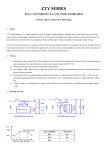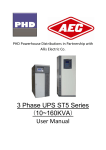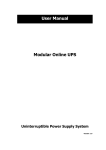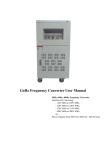Download apm_wbs
Transcript
WBS HARDWIRED SERIES 4-60KVA MAINTENANCE BYPASS SWITCH Man 440 Issue 7 1 1. INTRODUCTION ........................................................................................................................ 3 2. INSTALLATION .......................................................................................................................... 3 2.1 Connection of the Mains Supply............................................................................................ 3 2.2 Connection of the Input to the UPS....................................................................................... 4 2.3 Connection of the Output from the UPS ................................................................................ 4 2.4 Connection of the Protected Equipment................................................................................ 4 2.5 Connection of the Auxiliary Contacts (optional)..................................................................... 4 2.6 Initial switch on ..................................................................................................................... 4 3. MAINTENANCE BYPASS SWITCH OPERATION...................................................................... 5 3.1 Switching to Bypass Operation (for UPS maintenance and testing only)............................... 5 3.2 Switching to Bypass Operation (for UPS maintenance and complete isolation only) ............. 5 3.3 Disconnection of the UPS ..................................................................................................... 5 3.4 Reconnection of the UPS...................................................................................................... 6 3.5 Switching back to Normal Operation ..................................................................................... 6 4. Transient Voltage Surge Suppressor or TVSS (Optional). .......................................................... 6 4.1 TVSS Operation.................................................................................................................... 6 4.2 TVSS Access........................................................................................................................ 6 4. Appendix 1 4-10kVA Diagram..................................................................................................... 7 5. Appendix 2 10-60kVA Diagram................................................................................................... 8 Man 440 Issue 7 2 1. INTRODUCTION The Maintenance Bypass Switch (WBS) is a wall-mounted unit specially designed to allow maintenance and removal of the UPS without any disruption of the supply to the protected equipment (i.e. the load). It is fitted with a three-position switch that can be locked in 2 positions only (NORMAL and BYPASS), thus preventing accidental switching during normal and bypass operation. When the WBS is switched to the “NORMAL” position, backup is available from the UPS in the event of a mains supply failure. In the “BYPASS & UPS” position, no backup is available, but mains supply remains connected to the UPS. Finally when the WBS is switched to the “BYPASS” position, no backup is available and the mains supply is disconnected from the UPS. The “T” versions have additional transient voltage surge suppressor (TVSS) devices fitted. WARNING! The WBS should only be installed and operated by authorised and trained personnel 2. INSTALLATION WARNING: - The following procedure must be followed exactly. Failure to do so, could lead to exposure to hazardous voltages and disruption of the supply to the protected equipment. It is recommended that the following procedure be only carried out by a qualified electrician. THIS EQUIPMENT MUST BE EARTHED. Before commencing the installation ensure that the WBS is suitable for the UPS system for which it is to be used, the connection cable sizes can be found in the UPS user manual. Remove the gland plate, blanking grommets (if fitted) and front panel (panels) from the WBS, all plates and panels are secured by several retaining screws and are connected to the unit via an earth connection, this earth connection may be removed temporarily during the installation (the removable gland plate must be drilled to suit your particular gland requirements). Mount the WBS securely to an even surface (e.g. wall); this can be achieved using the four mounting holes located in the rear of the enclosure. Once the WBS is securely mounted the connections can be made as described in the next section: WARNING! Hazardous voltages will be present on the terminal blocks if the UPS or mains supply is switched on. Always ensure that the UPS and mains supply is switched off and isolated before proceeding. (Refer to UPS operation manual for correct indications). 2.1 Connection of the Mains Supply Feed the mains supply cables through the gland plate and secure, terminate the mains supply cables to the terminals marked “SUPPLY IN” as follows: For Single Phase Input Supply Wire Terminal Live (Brown) Terminal Marked L Neutral (Blue) Terminal Marked N Earth (Gn/Yw) Terminal Marked E For Three Phase Input Supply Wire Terminal Phase 1 (Red) - Terminal Marked L1 Phase 2 (Yellow) - Terminal Marked L2 Phase 3 (Blue) - Terminal Marked L3 Neutral (Black) Terminal Marked N Earth (Gn/Yw) Terminal Marked E Ensure that all terminals and glands are tight. Man 440 Issue 7 3 2.2 Connection of the Input to the UPS Feed the UPS input cables through the gland plate and secure, terminate the UPS input cables to the terminals marked “UPS IN” as follows: For Single Phase Input Wire Terminal Live (Brown) Terminal Marked L Neutral (Blue) Terminal Marked N Earth (Gn/Yw) Terminal Marked E For Three Phase Input Wire Terminal Phase 1 (Red) - Terminal Marked L1 Phase 2 (Yellow) - Terminal Marked L2 Phase 3 (Blue) - Terminal Marked L3 Neutral (Black) Terminal Marked N Earth (Gn/Yw) Terminal Marked E Ensure that all terminals and glands are tight. 2.3 Connection of the Output from the UPS Feed the UPS output cables through the gland plate and secure, terminate the UPS output cables to the terminals marked “UPS OUT” as follows: For Single Phase Output Wire Terminal Live (Brown) Terminal Marked L Neutral (Blue) Terminal Marked N For Three Phase Output Wire Terminal Phase 1 (Red) - Terminal Marked L1 Phase 2 (Yellow) - Terminal Marked L2 Phase 3 (Blue) - Terminal Marked L3 Neutral (Black) Terminal Marked N Ensure that all terminals and glands are tight. 2.4 Connection of the Protected Equipment Feed the protected equipment cables through the gland plate and secure, terminate the protected equipment cables to the terminals marked “SUPPLY TO LOAD” as follows: For Single Phase Load Wire Terminal Live (Brown) Terminal Marked L Neutral (Blue) Terminal Marked N Earth (Gn/Yw) Terminal Marked E For Three Phase Load Wire Terminal Phase 1 (Red) - Terminal Marked L1 Phase 2 (Yellow) - Terminal Marked L2 Phase 3 (Blue) - Terminal Marked L3 Neutral (Black) Terminal Marked N Earth (Gn/Yw) Terminal Marked E Ensure that all terminals and glands are tight. 2.5 Connection of the Auxiliary Contacts (optional) The auxiliary contacts are only to be used if required, they allow the position of the bypass switch to be monitored as follows: Switch Position Volt free Contact Status Normal Open Bypass & UPS Closed Bypass Closed Contact Rating - 20A @230Vac 2.6 Initial switch on Before the mains supply is applied to the WBS: ♦ Refit all of the covers that were removed during installation, not forgetting the earth connections. ♦ With the bypass switch in the normal position, switch on the supply. ♦ Start the UPS and confirm that the UPS operates correctly as described in its User Manual. ♦ Confirm that the TVSS device (if fitted) is operating correctly as described in it’s User Manual. ♦ The unit is now installed. Man 440 Issue 7 4 3. MAINTENANCE BYPASS SWITCH OPERATION WARNING! Always allow a 20 second break between switching positions 3.1 Switching to Bypass Operation (for UPS maintenance and testing only) NOTE: - Check that the UPS is working normally and that it is not working in battery operation mode (refer to UPS user manual). If these conditions are not met, disruption or even damage can occur to the UPS or protected load if the switch is operated. ♦ Turn the switch to the “BYPASS & UPS” position (central). ♦ The load is now supplied directly from the mains supply and the UPS still has input supply connected. ♦ The UPS may now be switched off or tested (refer to UPS user manual) without disrupting the load. 3.2 Switching to Bypass Operation (for UPS maintenance and complete isolation only) NOTE: - Check that the UPS is working normally and that it is not working in battery operation mode (refer to UPS user manual). If these conditions are not met, disruption or even damage can occur to the UPS or protected load if the switch is operated. ♦ Turn the switch to the “BYPASS & UPS” position (central). ♦ The load is now supplied directly from the mains supply and the UPS still has input supply connected. ♦ The UPS may now be switched off (refer to UPS user manual) without disrupting the load. ♦ Turn the switch to the “BYPASS” position (fully clockwise). ♦ The load will be continually supplied from the mains supply and the input supply to the UPS will now be disconnected. ♦ The UPS may now be maintained without disrupting the load (always check the terminals using a meter prior to touching). 3.3 Disconnection of the UPS WARNING! Hazardous voltages are always present within the WBS, unless completely Isolated from the UPS and Mains Supply. NOTE: - Check that the UPS is working normally and that it is not working in battery operation mode (refer to UPS user manual) If these conditions are not met, disruption or even damage can occur to the UPS or protected load if the switch is operated. ♦ Turn the switch to the “BYPASS & UPS” (central) position. ♦ The load is now supplied directly from the mains supply and the UPS still has input supply connected. ♦ Switch the UPS off completely following the UPS User Manual (ensuring the batteries are also isolated). ♦ Turn the switch to the “BYPASS” (fully clockwise) position. ♦ The load is still supplied directly from the mains supply but the mains supply to the UPS is now disconnected. ♦ WARNING: - Hazardous voltages are always present within the WBS, unless completely isolated from the UPS and Mains Supply. ♦ Lock the switch in position if necessary. ♦ Remove the cover from the WBS. ♦ Using a meter, confirm that no voltage is present. ♦ Disconnect the cables from the terminals marked UPS IN and UPS OUT. Man 440 Issue 7 5 ♦ Disconnect the cables connected to the UPS input/output terminals. ♦ The UPS can now be removed for maintenance. The load will continue to be supplied through the WBS. ♦ Replace all of the covers of the WBS and UPS. 3.4 Reconnection of the UPS WARNING! Hazardous voltages are always present within the WBS, unless completely isolated from the UPS and Mains Supply. ♦ Reconnect the UPS, following section 2 (2.2 & 2.3) found earlier within this manual. ♦ Once all connections have been made replace all covers and refer to section 3.5. 3.5 Switching back to Normal Operation WARNING! Always allow a 20 second break between switching positions ♦ Turn the switch to the “BYPASS & UPS” (central) position. ♦ The UPS now has input supply available, whilst the load is still supplied directly from the mains supply. ♦ Switch on the UPS ensuring correct operation (refer to UPS user manual). ♦ Check that the UPS is working normally and that it is not working in battery operation mode (refer to UPS user manual). If these conditions are not met, disruption or even damage can occur to the UPS or protected load if the switch is operated. ♦ Turn the bypass switch to the “NORMAL” (fully anti-clockwise) position. ♦ The load is now protected by the UPS. 4. Transient Voltage Surge Suppressor or TVSS (Optional). 4.1 TVSS Operation For the operation of the TVSS device located within the bypass switch, refer to the separate TVSS user manual. 4.2 TVSS Access Access to the TVSS device for maintenance or replacement purpose’s is as follows: ♦ WARNING! Hazardous voltages are always present within the WBS, unless completely isolated from the UPS and Mains Supply. ♦ Confirm that the device can be worked upon safely whilst connected to the mains supply, if it is not safe to work upon the device the mains supply will have to be isolated prior to cover removal (some TVSS devices utilise hot swap capability). ♦ To gain access, if safe to do so, remove the four screws that secure the TVSS viewing window to the upper cover. ♦ Refer to the TVSS user manual for further information. ♦ Once all the work has been carried out on the TVSS device, replace the TVSS viewing window and secure. Man 440 Issue 7 6 4. Appendix 1 4-10kVA Diagram Note: - Versions may differ slightly WARNING WHEN OPERATING THE BYPASS SWITCH, ALLOW A 20 SECOND INTERVAL BETWEEN SWITCH POSITIONS TO ALLOW THE UPS TO PHASE LOCK 1 1 BYPASS NORMAL BYPASS & UPS 2 3 1. 3-Position Rotary Switch 2. Terminal Cover 3. Gland Plate Man 440 Issue 7 7 5. Appendix 2 10-60kVA Diagram Note: - Versions may differ slightly BYPASS & NORMA 1 BYPASS & UPS NORMAL BYPASS 6 WARNING ! WHEN OPERATING THE BYPASS SWITCH, ALLOW A 20 SECOND INTERVAL BETWEEN SWITCH POSITION TO ALLOW THE UPS TO PHASE LOCK 2 DANGER - HIGH VOLTAGE ELECTRICAL SHOCK HAZARD Service to be performed by qualified personnel 5 3 WARNING REFER TO INSTRUCTIONS BEFORE REMOVING THIS PANEL 4 1. 2. 3. 4. 5. 6. Man 440 Issue 7 3-position Rotary Switch. Upper Cover. Lower Cover. Gland Plate. TVSS viewing/access window (optional) Typical TVSS device (optional) 8















